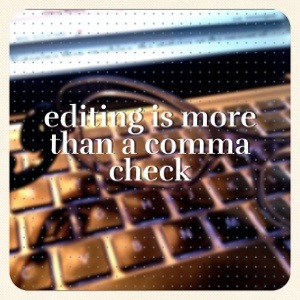
Is your editor doing the job you expect?
[dropcap]E[/dropcap]ditors can be expensive, and the quality of work you’ll get varies widely. Like anything else in life, you’ll want to research your editor choices and get referrals. Check out any books they’ve edited if they’re listed. Don’t be afraid to ask for titles if they aren’t.
Keep in mind that anytime you’re looking at the finished product, there’s no way to know who’s at fault for any mistakes. The mistakes could be the editor’s, they could be the author’s, or they could be the formatter’s. The author may have rejected changes they shouldn’t have or continued making revisions after the edit. The formatter may have introduced errors in formatting. Or the editor may have just not done a good job. Maybe the editor is too new and inexperienced to know better (a good reason to check the editor’s most recent titles). You just never know, so try to remember that when judging an editor through a novel.
You also don’t know what kind of edit the author requested. The author may have asked for a proofreading, not a copyedit. Typically a proofer would fix those comma errors, but if the comma errors are clearly throughout, and the author doesn’t want a copyedit, it might not be something the proofer will do. A proofread is meant to be done after a copyedit, so it’s not the job of the proofer to do a full copyedit. To do a full copyedit based on a proofer’s rate is unfair to the proofer.
Proofreading and copyediting are two very different jobs. Authors often confuse a proofread with a light copyedit. If you need someone to tame your compulsive comma abuse, you’re asking for a light copyedit. If you need someone to go over your MS one last time for any missed comma corrections and grammar errors, then you’re getting a proof. Be honest about your needs and hire appropriately. When you do, you’ll get the most out of your money.
Regardless of how much you don’t know about any particular past titles you’re checking, you’ll still want to know what the editor is catching and not catching, and looking over past work will help you figure that out. If you are seeing consistent comma mistakes, for example, then it’s not likely an introduced error. I know it’s hard to know if something is a mistake or an editorial style (some editor’s will place a comma where another wouldn’t), but it’s still worth taking a look, since it’s usually pretty obvious whether an editor can do the job. En dashes instead of em dashes, dashes with spaces, ellipses that look … like … this, single quotes, and interrobangs are just a few good signs not to use that editor. Even trade novels have typos and mistakes; what you want to know is how much and what kind. I’ve seen some horrendous trade novels; bad editing is not restricted to self-published novels, and there are many self-published novels with excellent editing.
No matter what, there are basic things a copyeditor should do. Let’s review what a copyeditor does. I’m including proofers, because it is technically editing, but I’m adding the distinctions between a proofer and a copyeditor, so you know what you’re getting with each. If you skip a copyedit and go straight to a proofreading, you might find that what you think you’re getting a proofer to do is beyond their scope of duty (and sometimes training). Some generous editors that receive a proofreading project that has not been edited may choose to continue with a very light copyedit if the errors are mild enough, but more often than not, they’ll return it with a note stating it’s not yet ready for proofing and offer copyediting services instead.
I often get files to format or proof from clients that were edited, and I find that many of them aren’t getting the full job of a copyeditor. Generally that means the author isn’t actually using trained editors. That’s not always true, and I can’t attest to an editor’s skill, or why an editor didn’t do something, but for the most part, not doing something means the editor isn’t trained.
A simple overview of editing in three steps. (This is not an explanation of what these three steps are, what goes on a style sheet, or how to do any of these three steps. That’s a post for another day. It’s only stating the top three things an editor should do for you.)
1. Mechanics, usage, and grammar
- PROOFER checks for any missed or introduced errors after a copyedit
- the last run through before printing/publishing
- no major changes, no rewrites, no revisions, no comments or suggestions
- solely to ensure everything is as it should be
- if using a proofer, indies should consider having the proofer view the final formatted version, since that’s really what a proofer should be looking at—the final product
- COPYEDITOR checks for mechanics, usage, and grammar but also knows expectations of what they edit
- fiction has virtually no real rules, even style guides are unwilling to impose upon fiction (and another link here)
- editors will have a unique style, such as the use of punctuation to enhance and/or support the writing
2. Prepare your manuscript for formatting or print
3. Create and provide a style sheet
- Style sheets are for the proofer, printer, and the formatter, not just the editor and author
- everyone working on the novel should receive the style sheet to refer to when they spot something that looks like an error (As a formatter, I’ve received files with inconsistent uses of space between chapters, scenes, and headings, but the author never had a style sheet for me to refer back to, which slows everyone down waiting for answers to questions a formatter shouldn’t have had to ask in the first place.)
Must your editor be trained? No, not necessarily. Many editors come up through the ranks and learn on the job by assisting. Some are self-taught. Should you run from a self-taught editor? Possibly. But not always. Self-taught doesn’t have to mean bad; we all start our careers at the bottom and claw our way up. I started out as a self-taught editor, as have many other fine editors that work freelance or in-house.
Typically a self-taught editor will charge less than someone that is trained, at least early on. You’d be wise to remember that, because you get what you pay for, so your research is critical here if you really want to get a quality service for the fee you pay.
Anyone self-taught should have the drive to properly study copyediting on their own. That doesn’t mean taking a grammar class and assuming they can do the job. Self-study requires a lot of discipline and drive, because it’s much more than a grammar class. I would expect anyone self-studying to have studied multiple copyediting textbooks and guides, not just a book on basic self-editing for dummies. I would expect that they’ve practiced editing on authors through forums or critique groups or any other method of finding author’s willing to let an editor practice on them. Hopefully they also sought out editor blogs, websites, forums, and if they really did the work, they know who some of the top editors are in their chosen field. I would expect them to know the terms used, the expectations of the area they choose to copyedit within (editing for fiction is not the same as editing for nonfiction, just as editing for magazines is not the same as editing for professional journals), what they are supposed to be looking for, how to query, what tools are used, and what to return to the client. All of that takes the same kind of motivation to learn that writing takes. Effort, research, and time. There are some very good self-taught editors, and you could easily find a gem. Check references, check their titles, and ask questions.
The more you know about what an editor does, the better you can judge how well an editor has been trained or self-trained. You may even be willing to be one of the first, if not the first client of someone trying to make their name. That’s perfectly okay. Editors learn and get better at their craft the same way everyone gets better at their job. They make mistakes, they learn from them, and they improve with every edit. The key is to be aware. Know the choice you’re making and what the risks include, and let it actually be a choice, not a mistake you made because you didn’t know better.
No matter if the editor is certified or self-taught, get samples. Don’t expect a large sample. Consider that most editors can do a moderate copyedit of 8-10 double spaced MS pages per hour. Keep your sample request low enough that it’s not imposing, but large enough that you can see what you’re getting. You can expect that to be anywhere from 2-4 pages. Of course, if the editor you’re querying has instructions for sample submissions, follow them.
In essence, knowing what a copyeditor does will help you know what kind of editor you’re hiring. An excellent forum post that goes into a little more detail on potential questions to ask can be found on Absolute Write. Know what you’re paying for, and know what you want. It’s the only way to be sure you’re getting what you pay for and the quality of editing you expect.






No Comments